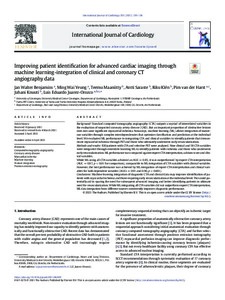Improving patient identification for advanced cardiac imaging through machine learning-integration of clinical and coronary CT angiography data
Maaniitty Teemu; Knuuti Juhani; Benjamins Jan Walter; Yeung Ming Wai; Juarez-Orozco Luis Eduardo; van der Harst Pim; Klén Riku; Saraste Antti
https://urn.fi/URN:NBN:fi-fe2021093048184
Tiivistelmä
Background
Standard computed tomography angiography (CTA) outputs a myriad of interrelated variables in the evaluation of suspected coronary artery disease (CAD). But an important proportion of obstructive lesions does not cause significant myocardial ischemia. Nowadays, machine learning (ML) allows integration of numerous variables through complex interdependencies that optimize classification and prediction at the individual level. We evaluated ML performance in integrating CTA and clinical variables to identify patients that demonstrate myocardial ischemia through PET and those who ultimately underwent early revascularization.
Methods and results
830 patients with CTA and selective PET were analyzed. Nine clinical and 58 CTA variables were integrated through ensemble-boosting ML to identify patients with ischemia and those who underwent early revascularization. ML performance was compared against expert CTA interpretation, calcium score and clinical variables. While ML using all CTA variables achieved an AUC = 0.85, it was outperformed by expert CTA interpretation (AUC = 0.87, p < 0.01 for comparison), comparable to ML integration of CTA variables with clinical variables. However, the best performance was achieved by ML integration of expert CTA interpretation and clinical variables for both dependent variables (AUCs = 0.91 and 0.90, p < 0.001).
Conclusions
Machine learning integration of diagnostic CTA and clinical data may improve identification of patients with myocardial ischemia and those requiring early revascularization at the individual level. This could potentially aid in sparing the need for subsequent advanced imaging and better identifying patients in ultimate need for revascularization. While ML integrating all CTA variables did not outperform expert CTA interpretation, ML data integration from different sources consistently improves diagnostic performance.
Kokoelmat
- Rinnakkaistallenteet [19218]
